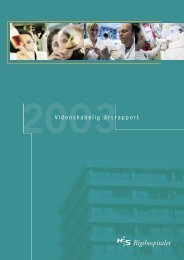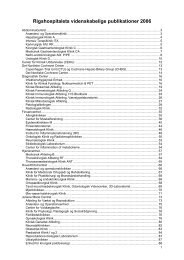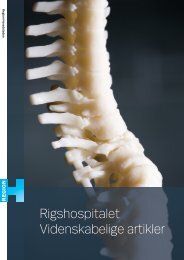View - CTU
View - CTU
View - CTU
You also want an ePaper? Increase the reach of your titles
YUMPU automatically turns print PDFs into web optimized ePapers that Google loves.
2008). Another recent Cochrane review investigated the pulp management for caries<br />
in adults (Miyashita et al. 2007). Four trials were found suitable for inclusion, but<br />
again no definitive indication as to the most effective method of pulp treatment of<br />
carious teeth was found, and the review authors concluded that further well-designed<br />
trials are needed. Randomized trials are internationally considered the gold standard<br />
for comparing interventions (Gluud & S0rensen 1995, Chalmers 2001, Gluud 2006a)<br />
and at the top of the hierarchy of evidence (Sackett et al. 2000, Gluud 2006a, Gluud<br />
2006b). Dental research in general is progressing towards adopting adequate trials,<br />
reducing the risk of systematic errors ('bias') and the risk of random errors ('play of<br />
chance') (Sjogren & Halling 2001 ), and utilising systematic reviews of such trials<br />
(Bader & Ismail, 2004 ). The strategy for managing deep caries and pulp inflammation<br />
has been expressed differently through the years (Bj0rndal 2008). The variation may<br />
be related to: (i) lack of non-invasive devices that could measure the status of the<br />
pulp, (ii) the tradition of not defining the depth and progression rate of the caries<br />
lesion, (iii) the lack of randomized clinical trials investigating the outcome of deep<br />
caries excavation. It has been suggested (Miyashita et al. 2007) that a decision must<br />
be made as to whether all carious tooth tissue should be removed, and this warrants<br />
a clinical trial in itself. Another category of clinical trials should relate to the<br />
management of the exposed pulp.<br />
Hypothesis Illa:<br />
One direct complete excavation procedure is as good as a less invasive stepwise<br />
excavation approach to prevent root canal treatment.<br />
Aim Illa:<br />
To carry out a randomized clinical trial comparing stepwise excavation versus direct<br />
complete excavation on deep caries in adults, using pulp exposure, 1-year pulp<br />
vitality without apical radiolucency, and pain as the outcome measures.<br />
Hypothesis I/lb:<br />
Treatment of pulp exposures with direct pulp-capping is as good as partial pulpotomy<br />
in terms of pulp survival.<br />
Aim /fib:<br />
To carry o<br />
pulpotomy<br />
apical radii<br />
Context:<br />
Danish N<br />
Remuner<br />
Fig. 5. In St<br />
Trial desi£<br />
Definitions<br />
The numbe<br />
sample siz,<br />
detect a<br />
excavation<br />
error of 10'<br />
pulp vitalit)<br />
patients, ta<br />
Consecutiv<br />
participatec<br />
the enrolm<br />
numbers o·<br />
trial would<br />
Inclusion a<br />
16








